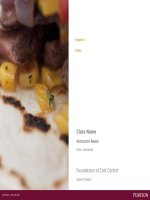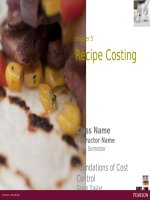Foundations of cost control by daniel traster chapter04
Bạn đang xem bản rút gọn của tài liệu. Xem và tải ngay bản đầy đủ của tài liệu tại đây (2.58 MB, 37 trang )
chapter 4
Yields
Class Name
Instructor Name
Date, Semester
Foundations of Cost Control
Daniel Traster
Opening Questions
You have a dinner party for 8 people.
The onion tart calls for 4 oz of caramelized onions per person.
How many pounds of onions should you order?
2# is not the answer
You lose some weight in peeling and some during cooking as water evaporates
2
Key Terms
As Purchased (AP)
form (and measure) of a
product as it comes from a purveyor.
Yield
weight or volume of a product remaining after trim
and waste are removed. In some cases, includes cooking
loss.
Edible Portion (EP)
form (and measure) of a
product after it has been prepped (in some cases, cooked)
Yield percent (Y%)
and waste or loss has been removed. For produce, EP
that results on average during the preparation stage.
usually refers to pre-cooked yield after trimming and knife
work is done.
ratio of useable product
Calculating Yield %
1.
Weigh raw produce in AP form.
2.
Process the product as you would for a recipe.
3.
Weigh the EP result without the waste.
4.
Calculate Y% (decimal form) = EP ÷ AP
4
Example 4a
You process 17# of cauliflower and get 10# of florets. What is the yield %?
EP %
=
=
=
0.588 or 58.5%
5
Example 4b
You process 8# of celery and are left with 6# 7oz for crudité. What is the yield
%?
Convert to all pounds or all ounces.
7 oz ÷ 16 = 0.4375, so 6#7oz = 6.4375#
Y%
=
=
=
0.805 or 80.5%
6
Notes on Y% for Produce
•
Y% changes with type of processing, even on the same vegetable or fruit.
•
Formula assumes trim is not used elsewhere; Y% is higher if waste is put to
use.
•
Y% should remain consistent for similarly trained employees across days.
•
Y% for items portioned by count is 100%.
•
For “each” items bought in a size range assume the lowest number in the
range.
7
EP-AP-Y% Graphic Formula
EP
AP x Y%
8
Example 4c
How many oz of broccoli florets can you get from 10# of broccoli if the
yield for florets is 68%?
EP = AP X Y% =
10# X 0.68 = 6.8#
6.8# X 16 = 108.8 oz
9
Example 4d
How many pounds of jicama should you purchase to get 4# of julienne
jicama if Y% of julienne jicama is 88%?
AP
=
=
=
4.55# or 5# rounded
When calculating AP quantity to purchase, always round up to ensure
enough EP product
10
Example 4e
A chef serves 3 oz portion of sliced beets per customer. She has 12# of AP
beets in the walk-in, and Y% for sliced beets is 90%. How many guests can
she serve?
EP = AP X Y% = 12# X 0.90 = 10.8#
10.8# X 16 oz/# = 172.8 oz
172.8 oz ÷ 3 oz/guest = 57.6 or 57 guests
When calculating number of portions, always round down. (Cannot serve a partial
portion.)
11
AP vs. EP Cost
Because you pay for edible product and its trim/waste when you purchase,
the true EP cost of an ingredient is not the same as its AP cost unless the
product has 100% yield
AP cost (per unit) = AP$
EP cost (per unit) = EP$
12
AP$-EP$-Y% Graphic Formula
AP$
EP$ x Y%
13
Example 4f
What is the EP cost per pound for radishes if a 10# case costs $14.40 and Y
% is 86%?
Cost per #
=
EP$
=
=
=
$1.44/#
=
=
$1.674 or $1.67/#
14
Example 4g
What is the AP cost/# for heirloom tomatoes budgeted at $2.17/# EP cost
with a 96% yield?
AP$ = EP$ x Y% =
$2.17/# x 0.96 =
$2.08/#
15
Butcher’s Yield Test
The Butcher’s Yield Test calculates EP weight and cost per # or oz.
Differs from basic yield test because large cut of meat has by-products of
different values (like buying a bag of unlabeled cuts of meat, but you only
know the total cost for the bag).
16
Conducting Butcher’s Yield Test
1.
Butcher a large cut of meat, keeping main item, by-products, and scraps in
separate piles. Record weight of each pile on spreadsheet.
2.
Calculate percent of total weight that each item represents.
3.
Research on a purveyor’s price list the price per pound for each useable byproduct.
17
Conducting Butcher’s Yield Test
4. Calculate extension or total value of each by-product using the purveyor list
price.
5. Calculate the value of the main item as total value of original cut minus value of
all by-products.
6. Calculate cost per useable pound as value of main item ÷ weight of main item in
pounds. Divide result by 16 to get cost per useable oz.
18
Conducting Butcher’s Yield Test
7. Determine cost multiplier as cost per useable pound ÷ AP cost per pound
Cost multiplier (CM) allows chef to calculate cost per useable pound for this cut in
the future as AP cost/# changes.
To calculate new cost per useable pound in future, multiply new AP cost/#
X CM
19
Example 4h
Item: Turkey; Grade A.
Weight: 16# 4 oz
Product
AP price/#: $0.79/#
Total Cost: $12.84
Weight
% of total
Purchase
Total Value
Cost per
Cost per
Cost Mult. (CM)
Step 1
Step 2
price/#
Step 4
useable #
useable oz
$7.76
$1.75
$0.11
2.22
Step 5
Step 6
Step 6
Step 7
Step 3
Thighs
2# 11oz
16.5%
$0.58/#
$1.56
Wings
1# 3oz
7.3%
$0.42/#
$0.50
Bones
7# 12oz
47.7%
$0.39/#
$3.02
Scraps
3oz
1.2%
No value
$0
Trimmed Breast
4# 7oz
27.3%
Total
16# 4oz
100%
$12.84
Example 4i: Using the Cost Multiplier (CM)
Turkey is now selling for $1.09/#. The cost multiplier for the breast meat is
2.22. What is the new cost per useable pound and per useable ounce for
the breast meat.
Cost/useable # = AP$/# x CM =
$1.09÷ (# x 2.22)
= $2.42/#
Cost/useable oz = cost/useable # ÷ 16
= $2.42/# ÷ 16 =
$0.15/oz
21
Notes on Butcher’s Yield Test
•
Cost per useable pound generates cost multiplier.
•
Cost per useable ounce helps determine cost per portion (usually known in oz).
•
CM allows chef to adjust cost/oz or # without redoing entire yield test.
22
Notes on Butcher’s Yield Test
•
Reasons to redo test: the butcher’s skill has changed or the price of byproducts has changed significantly in relation to AP$ of whole cut.
•
Test results are relevant only to that cut with same specs.
•
Test allows chef to determine the better deal – butchering in-house or buying
pre-fab.
23
Cooking and Trim Loss Tests
Account for loss during cooking and during post-cooking portioning.
•
Usually for large roasts
•
Irrelevant for items sold by pre-cooked weight
•
Cooking loss = oven-ready weight – cooked weight
24
Example 4k
12# 4oz roast cooks down to 10# 15oz fully cooked. Calculate cooked
weight % and cooking loss % in relation to oven-ready roast.
Percent
=
=
=
0.893 or 89.3%
Cooking loss % = 100% - 89.3% = 10.7%
25









